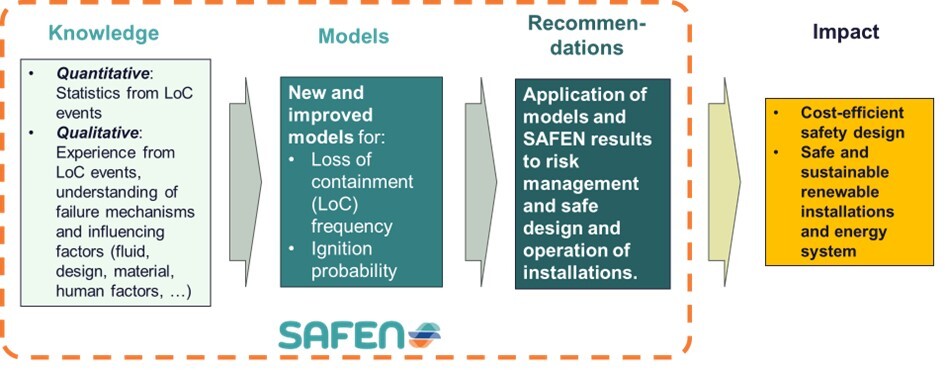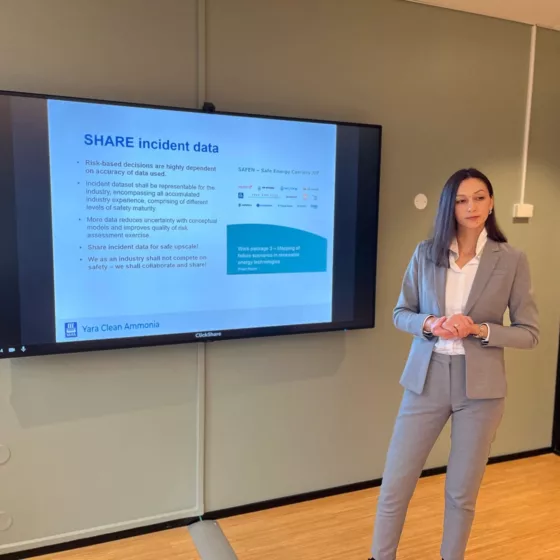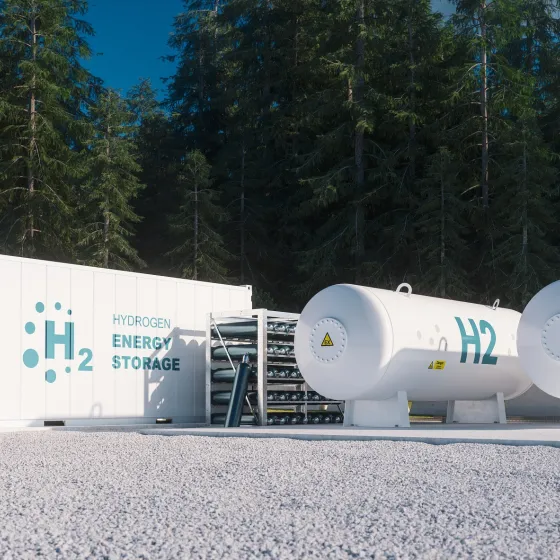
SAFEN
SAFEN – short for "Safe Energy Carriers" – is a Joint Industry Project (JIP), where a strong and diverse group of industry partners share experiences and together address knowledge gaps in understanding failure mechanisms, hazards, and accident situations in renewable technologies involving hydrogen, ammonia, and CCS (carbon capture and storage).
The overarching SAFEN JIP objective is to establish the knowledge required to develop risk-based methodologies enabling cost-efficient safety design for hydrogen, ammonia, and CO2 facilities.
The knowledge comprises quantitative knowledge (e.g. statistics on loss of containment events) and qualitative knowledge (e.g. experience from events or expert knowledge on failure mechanisms). This is the basis for new and improved models for loss of containment frequencies for different types of equipment (process equipment, storage tanks, etc.) and fluids, and for ignition probability models (hydrogen and ammonia). SAFEN will provide recommendations for application of models and SAFEN results to risk management and safe design and operation of installations, e.g. by guidelines on design and operation of installations.

Timeline and partners
SAFEN was initiated and is led by Safetec. The project is executed in close collaboration with the consultancies DNV, Vysus Group, Gexcon, and Proactima.
Industrial partners include Aker Horizons, Equinor, Gassco, Gen2 Energy, GreenH, HSE, HYDS, Lloyd’s Register, the Norwegian Maritime Authority, Storegga, Swagelok, Vår Energi, and Yara, which contribute with financial support, data input, system description, and industry experience to the project.
In addition, SAFEN has the associated members DSB, Energy Institute, Havtil, NEL, RIVM, and World Class Maintenance, which contribute with knowledge input and insight.
The SAFEN JIP Phase 1 was formally kicked-off in March 2022 and completed in September 2023. The completion of Phase 1 was immediately followed by the start-up of Phase 2, which is planned to be completed in 2025.
HICON
In parallel with the initiation of SAFEN Phase 2, a spin-off project named HICON – Hydrogen Ignition CONtrol was initiated.
HICON is an Innovation Project for the Industrial Sector with financial support from the Research Council of Norway. The project is led by Safetec. Industrial partners include Proactima, Vysus, Aker Horizons, Equinor, Gassco, Gen2 Energy, Vår Energi, Yara, Gexcon, DNV, BAM and PTB.
In HICON, experiments on ignition of hydrogen will be performed to gain better knowledge on hydrogen ignition mechanisms as a basis to improve hydrogen ignition probability modelling, design of the ignition control barrier elements, and overall hydrogen risk management.
HICON was kicked off in September 2024 and is planned to be completed around the end of 2025.
SAFEN and HICON news
Results and reports
Publications from SAFEN:
- Proceedings of the 15th International Symposium on Hazards, Prevention and Mitigation of Industrial Explosions: https://zenodo.org/records/126...
- The SAFEN Hydrogen Ignition probability model (page 68)
- FABIG Technical meeting 106 - Loss of Containment and Ignition Modelling for Renewable Technologies Involving Hydrogen, Ammonia & CCS: https://fabig.com/publications...
- Here you can find many presentations showing results from SAFEN Phase 1
- FABIG Technical meeting 108: Harnessing History: Safe Design and Operation of Future Energy Systems: https://fabig.com/publications...
- Ingar Fossan: “Data sharing - The key to cost-effective risk assessments for the low carbon industries”
- International Process Safety Week (IPSW): https://ipsw24.vfairs.com/
- Day 4: Ingar: Fossan "Probabilistic modelling - Strengths and weaknesses”
From SAFEN Phase 1, the following reports are available for SAFEN participants on the SAFEN internal pages:
- ST-17462-3 SAFEN Database outline: This report contains definitions of central terms, specification of data field parameters, and suggestions for potential database IT solutions for a Loss of Containment events database.
- ST-17462-5 Mapping of failure scenarios in renewable energy technologies: This report provides a summary of the knowledge base on failure mechanisms and failure causes based on available statistical data and description of incidents from a variety of sources. Furthermore, the report describes the dominant failure scenarios believed to be relevant for the H2, NH3 and CO2 industry.
- ST-17462-6 Human reliability analysis of loading operations: This report describes the methodology and results from and Human Reliability Analysis (HRA) on loading operations (shore to ship: crude oil loading from caverns on an onshore storage facility to a tanker through loading arms).
- ST-17462-1 Ignition source literature study: This report provides a review of ignition mechanisms and models for hydrogen and ammonia.
- ST-17462-2 Research campaign for ignition mechanisms: This report proposes an experimental campaign on hydrogen ignition to improve the knowledge base on ignition mechanisms.
- ST-17462-4 SAFEN Risk modelling and input to risk management: This report describes the different models developed in SAFEN Phase 1:
- Loss of Containment (LoC) models (1st version) for hydrogen, ammonia and CCS facilities including its fundamental principles and basis for: process equipment, loading operations, and method / LoC model for storage tanks.
- Ignition probability models (1st version) for hydrogen including its fundamental principles and basis.
- Risk analyses and risk management guidance.
Contact us about SAFEN:

Principal Safety Adviser
thomas.welte@safetec.no

Innovation and Development Manager
ingar.fossan@safetec.no







